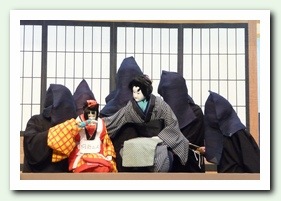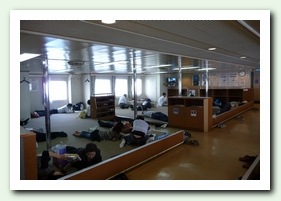Postscript:
After Temple 1, we returned by train to Tokushima where we spent a few days staying in the Toyoko Inn business hotel relaxing and contemplating our pilgrimage.
Tokushima is famous for its puppet theatre, which we enjoyed.
And one last okonomiyaki – do it yourself.
We wanted to continue Koyasan, on Honshu, the headquarters of Shingon Buddhism and resting place of Kobo Daishi. Traditionally henro go to Koyasan to give thanks for a safe pilgrimage.
We had heard that the Kumano Kodo would lead from the coast on Honshu to Koyasan, so full of blissful ignorance we took the ferry from Tokushima to Wakayama, then a train to Kii Tanabe on the western coast of the Kii peninsula, then a bus to Takijiri-oji and started walking.
It slowly dawned on us that this was not really the way to Koyasan, although such a walk would be possible, it would be very difficult and one would need to carry food and water for 4 days.
But, it turned out to be a World Heritage walk of considerable cultural and spiritual significance and perhaps the most beautiful walk we have done, hard too. So we walked for 4 days via Kumano Hongu Taisha to Kii Katsuura the eastern coast. Here is a slide show of the walk (sorry – pictures only, no story). Kumano Kodo
You can find out more about Kumano Kodo here:
http://www.tb-kumano.jp/en/index.html
Well there is a way that you can walk at least part of the way from Wakayama to Koyasan. It is via the Koyasan’s Choishi Stupa Route. However we finished the Kumano Kodo exhausted and wet, not feeling much like another day’s climb so we took the train instead. The train runs up a pretty valley and then a cable car takes you to Koyasan where we proceeded to Kobo Daishi’s resting place. We left our walking sticks there and departed on the next cable car down. Here’s a slide show Koyasan (again pictures only)
(For more information on Koyasan and maps: http://www.shukubo.jp/eng/)
If you are interested in Nara (Japan’s original capital) or Kyoto (seat of Japan’s imperial court from 794 until 1868), click for a slide show of our pictures:


